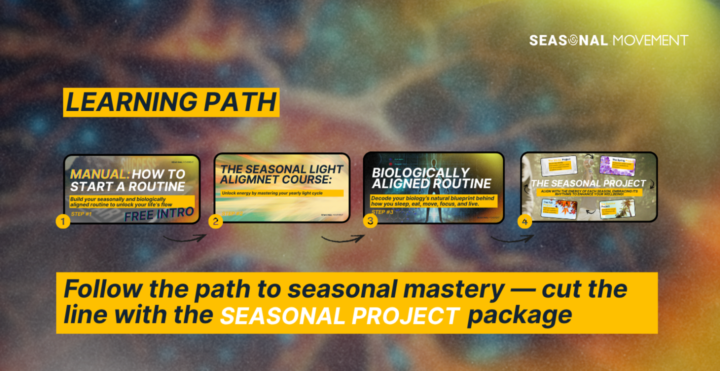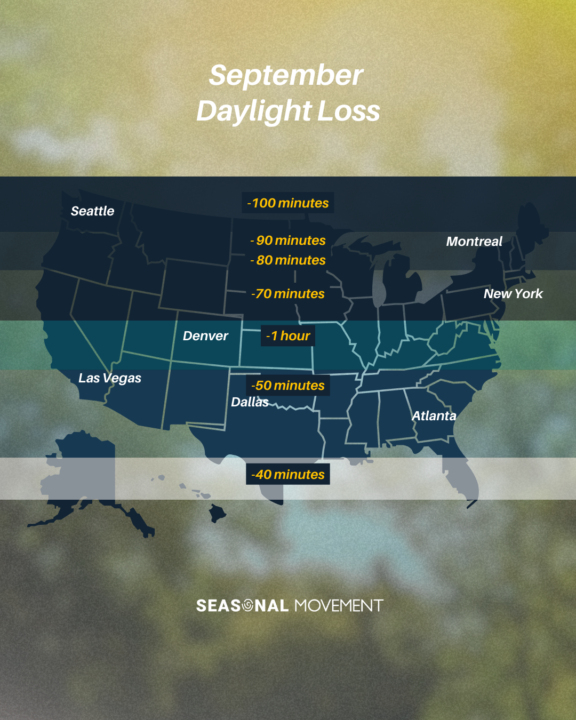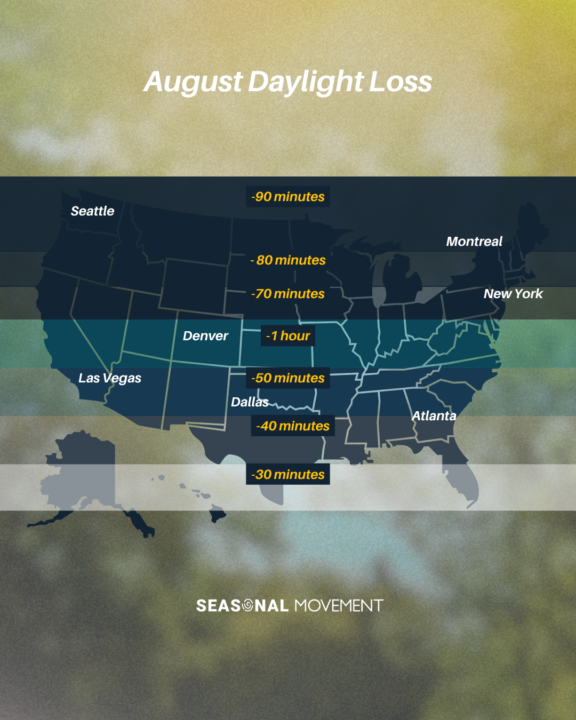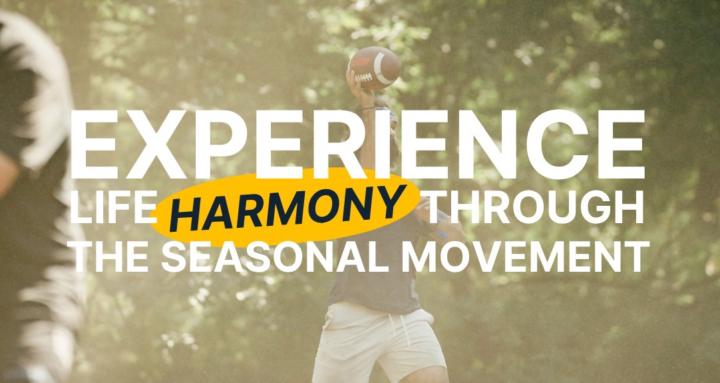🌿 Start Your Seasonal Journey
Welcome to The Seasonal Movement! Here’s your path to align your rhythm, energy, and lifestyle: 1️⃣ Manual: How to Start a Routine (Free Intro) 2️⃣ The Seasonal Light Alignment Course 3️⃣ Biologically Aligned Routine 4️⃣ The Seasonal Project — your full transformation ⚡ Ready to go all in? Follow the full path — or cut the line with the SEASONAL PROJECT package to reach mastery faster.
1
0

September: The month when daylight disappears the fastest
As summer fades and autumn approaches, nature reminds us of an inevitable shift: the days grow shorter, and they do so at a faster pace in September than in any other month of the year. September is when we lose the most daylight minutes each day, all due to the tilt of Earth’s axis and its orbit around the Sun. How much daylight do we lose? - In the northern states, such as Montana and the Dakotas, as much as 100 minutes of daylight are lost throughout September. - In the central regions, cities like Denver or Kansas City experience around 70 minutes of loss. - In the southern states, from Texas to Florida, the decrease is smaller but still noticeable: between 40 and 50 minutes. This phenomenon occurs because the Northern Hemisphere gradually tilts away from the Sun after the summer solstice in June. In September, this change accelerates, paving the way for the autumn equinox (around September 22 or 23), when day and night are nearly equal all over the world. More than just an astronomical fact The loss of daylight impacts much more than just the length of our days: - Mood and energy: Many people feel more tired or melancholic, a prelude to what is known as Seasonal Affective Disorder (SAD). - Nature: Plants, animals, and entire ecosystems respond to this shift in light by adjusting their biological rhythms. - Daily life: Outdoor activities get shorter, and our sense of time can make it feel like the days “fly by” more quickly. A reminder of natural cycles: While it may seem that darkness is gaining ground too quickly, this adjustment is part of Earth’s natural balance. The shortening of daylight in September prepares us for the calm of autumn and the stillness of winter, reminding us that life flows in cycles and that every season has its own purpose.
0
0

Meditation isn’t about trying, It’s about noticing
We often hear people say, “I’m trying to meditate.” But here’s the truth: If you’re trying to meditate... you’re missing the point. Because effort, the act of “trying”, comes from the mind. And meditation is not about the mind doing more. It’s about awareness watching the mind. Effort blocks awareness: When you “try hard” to meditate, you're just adding more noise. You're thinking about how to sit, how to breathe, how to feel. But meditation isn’t something you do. It’s something you notice. It’s not about doing. It’s about being, fully present, fully aware. Observation over identity: True meditation begins when you become the observer of your mind, the part of you that notices thoughts instead of being led by them. And here's the twist: The moment you call yourself a "meditator"... you've stepped into a role. An identity. A story. But meditation isn’t a role. It’s not a title. It’s a state of awareness that happens in any moment, whether you're sitting still or moving your body. Meditation can happen anywhere: You don’t need incense or silence or lotus position. You can meditate while walking, cooking, dancing, exercising. Because meditation isn’t about being still. It’s about being in flow. Being aware of your experience, instead of trying to control it. Inner Work + Outer Work: Want to do the inner work? Amazing. Just don’t forget about the outer work. The environment you live in, both physical and mental, shapes your biology, your thoughts, your feelings. And guess what? There’s no real line between your “outer” world and your “inner” world. That separation is an illusion created by the ego. It’s all connected. You are a system, not a split. Let’s do the work: Together If this message resonates with you, if you're curious about how to align your biology, your awareness, and your environment... Let’s grow together. Because the work doesn’t start in silence. It starts in awareness.

Living in Sync with the Seasons
For years, summer was my season. The long days, the warm light, the feeling of endless energy... Everything seemed to click. My routines thrived, I would train harder, work faster, create more... It felt like nothing could stop me. Until winter arrived, and it always did. It was like hitting an invisible wall. The same habits and effort produced completely different results. My focus slowed, my energy dipped, my motivation faded... No matter how much I pushed, nothing worked the same way. Like many people, I blamed myself. I thought I needed more discipline, more structure, more biohacks. But the truth was simpler, and much more powerful. Your environment doesn’t stay the same all year and neither does your biology. It took me 15 years of trial, error, and frustration to understand that light exposure, seasonal changes, and shifts in our circadian rhythm directly influence our mood, motivation, recovery, and even identity. I wasn’t lazy. I was out of alignment. When I began matching my habits to the season, working with my biology instead of against it... Everything changed. I stopped burning out. My business maintained steady growth, my personal life felt more balanced. And here’s the twist: Winter became my favorite season. It’s when I now grow the most, because I’ve learned how to adapt, reset, and use the natural rhythm of the year to my advantage. Sustainable growth isn’t about pushing harder all the time. It’s about knowing when to push, when to recover, and how to let the seasons shape your strategy. As we transition into a new season, ask yourself: are you forcing summer habits in winter conditions? Or are you adjusting to thrive year-round?
2
0

August Daylight Loss: what it is and how to adapt
As summer begins to wind down, a subtle yet powerful shift is happening all around us and within us. It’s called August Daylight Loss, and it refers to the rapid decrease in natural light that occurs in many parts of the Northern Hemisphere during the month of August. What’s Happening? Depending on where you live, you may lose anywhere between 30 to 90 minutes of daylight this month alone: - Seattle: -90 minutes - Denver: -1 hour - New York: -70 minutes - Dallas: -40 minutes - Miami: -30 minutes While it may not seem drastic day to day, this gradual loss can have a cumulative effect on your mood, energy, and biological rhythms especially as it disrupts melatonin and cortisol production, the hormones that regulate sleep, stress, and alertness. Why It Matters: Light is one of the most powerful signals for your circadian rhythm. When light exposure decreases: - Your energy may dip - Sleep becomes irregular - Motivation drops - Emotional regulation can feel harder And if you’re not aware of it, you might think you’re simply "burned out" or "being lazy", when in reality, your biology is adjusting to less solar input. How to Prepare for August Daylight Loss The good news? You can adapt and even thrive, through this seasonal shift. Here’s how: 1. Anchor Your Morning With Natural Light: Get sunlight exposure within 30–60 minutes of waking up. This helps set your circadian clock and boosts cortisol at the right time. 2. Dim Your Evenings: Use warm lights or candles at night to signal wind-down time. Avoid bright white lights after sunset, they trick your brain into thinking it’s still daytime. 3. Establish a Consistent Sleep Window: Go to bed and wake up at the same time daily. Stabilizing your sleep supports hormonal balance as daylight fades. 4. Supplement with a Happy Light (if needed): Especially in northern cities, consider using a 10,000 lux light box in the morning to simulate sunlight. 5. Move Your Body (Gently): Even a 20-minute walk can help regulate mood and promote restful sleep. Bonus if you do it outdoors!
3
0

1-15 of 15

skool.com/theseasonalmovement
Harness seasonal energy with scientifically backed seasonal routines to boost overall well-being throughout the year.
Powered by

